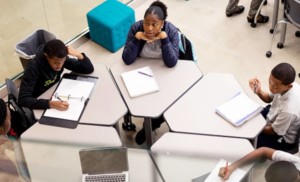Increase Social Awareness and Build Culture: Action Steps from 4 Schools

As schools across the country seek to integrate social emotional learning (SEL) strategies, increasing social awareness is an integral component. This is particularly true because social awareness is a prerequisite for treating all people with respect and building strong relationships.
A great starting place is to replace unconscious assumptions with curiosity. This is particularly compelling, because curiosity leads to questions that create understanding and expanded awareness. This is a much needed contrast to comparison, which can lead to potentially misguided judgements about the meaning of someone’s looks, actions or words.
Building social awareness takes enough humility to know you don’t have all the answers, and the confidence to admit it. It also takes dedicating time and energy to increasing awareness. Mayerson Academy is challenging EdLeaders to take 5 minutes per day (#5toThrive) to build SEL skills—and the non-profit organization, based out of Ohio, is also providing a free Toolkit to help.
Utilizing toolkits, SEL curriculum and other resources is invaluable—and so is the opportunity to gain understanding of how other schools are increasing social awareness.
1. Shaw Middle School: Social Intelligence
Principals Jon Swett and Shawn Jordan of Shaw Middle School are dedicated to promoting SEL. At Shaw, staff members teach students the term social intelligence as one of the character growth traits emphasized. They provide real-life examples of criteria for students:
- Was able to find solutions during conflicts with others
- Showed that he/she cared about the feelings of others
- Adapted to different social situations
- Chose peer group wisely

 Students set social goals based on the growth traits they recognize are needed not only for personal growth, but specifically to help them accomplish their academic goals. Jon says, “We consider social growth the ‘how’ and grades as the ‘what.’ Further, academic and social goals are connected to students’ Education to Career Plan and their dream statements.”
Students set social goals based on the growth traits they recognize are needed not only for personal growth, but specifically to help them accomplish their academic goals. Jon says, “We consider social growth the ‘how’ and grades as the ‘what.’ Further, academic and social goals are connected to students’ Education to Career Plan and their dream statements.”
Staff deliberately model through their own behavior in the classroom, and students thank their teachers by filling out a “Staff Recognition” bookmark, identifying a trait noticed and a short personal note of appreciation.
These sorts of activities are also included in Mayerson Academy’s Thriving Learning Community program.
2. Grandview High School: Culture of Kindness
According to CTE Director Steve Long, “proactive” is a word that describes their approach to social awareness. Students are at the center, with the Associated Student Body (ASB) taking the lead on many activities to address social awareness. Examples include bully awareness week, special needs awareness and service projects. Grandview has leveraged the College Spark Washington college readiness grant to build its advisory structure and academic supports, and promote access for all students. A couple of examples of social awareness focused initiatives that were supported through advisory include:
- Respect for all. “Spread the Word to End the Word” focuses on integrating students with special needs into the school’s mainstream so that they feel accepted. Part of that includes choosing a duke and duchess for the homecoming activities. Student are encouraged to sign a pledge to abolish the word “retarded.” The week ends with an assembly where students with special needs compete in floor hockey with leadership students. It is annually one of the school’s most spirited assemblies.
- Service Projects. Grandview uses its advisory program to facilitate Adopt-A-Family efforts at Christmas time, and to combat hunger through the March Madness to Give. By leveraging the event to coincide with the NCAA basketball tournament, advisory groups participate in a tournament to see which class donates the most items to combat hunger. Last year, students raised over 4000 items that were donated to a local food bank. The friendly competition was exciting, including a fantastic “Final-Four” battle.
3. Burlington Edison School District: Diversity as Solution
Burlington Edison School District’s Executive Director of Teaching and Learning, Casey Knudsen says, “I believe that the upside of America lies within our diversity.” The district is committed to living out this important value, and accordingly, students understand the expectation and opportunity. Casey cites research that has influenced his commitment:
“Beyond changing the futures of individual students, investing in diversity is critical to the future of the world, let alone our country. Scott Page, who directs the Center for the Study of Complex Systems at the University of Michigan, has conducted research on the link between diversity and improved problem solving. In his book, The Difference, Page explains that the problems that we face in the world today are inherently more complex and more connected, and, therefore, more difficult to solve. His research shows that when solving large complex problems, diverse groups of thinkers outperform highly intelligent individuals working alone.”
Burlington-Edison recognizes that, in order for groups to capitalize on the full benefits of their diversity, they must know how to work together. The only way that this can happen is if students are provided the time and opportunity to work together in diverse groups. This means that we must eliminate the sorting mechanisms inherent in our schools.
4. Deer Park Community City Schools: Thriving Learning Communities
As described in an EdWeek aricle, Deer Park Community Schools and other schools across the country are taking an innovative, blended, and strengths-based approach to improving school culture. Thanks to a partnership between Mayerson Academy, VIA Institute on Character and Happify, students are identifying and developing character strengths.
The Thriving Learning Communities curriculum—which addresses themes like self-awareness, self-management, social awareness and more—is at the heart of Deer Park’s SEL efforts. Mayerson Academy provides an easy entry point with a set of simple five minute activities to promote emotional well-being and social awareness.
School leaders are encouraged to access the related toolkit for use with staff.
Click the icon to download the 5 to Thrive 30 Day Culture Challenge Toolkit.
Social awareness is sure to increase when school leaders access great materials and learn from the examples of other schools
Read More:
- How Two Minutes of SEL Can Change the Tone for the Day
- On Becoming More Than Preparing: 10 Tips on Developing Humans
- Improve Your Self-Management Strategies.
This post is a part of a blog series highlighting the 5 to Thrive School Culture Challenge produced in partnership with Mayerson Academy (@MayersonAcademy). Download the free Toolkit and join the conversation on Twitter using #5toThrive or #EdLeaders.
Stay in-the-know with all things EdTech and innovations in learning by signing up to receive the weekly Smart Update. This post includes mentions of a Getting Smart partner. For a full list of partners, affiliate organizations and all other disclosures, please see our Partner page.




0 Comments
Leave a Comment
Your email address will not be published. All fields are required.